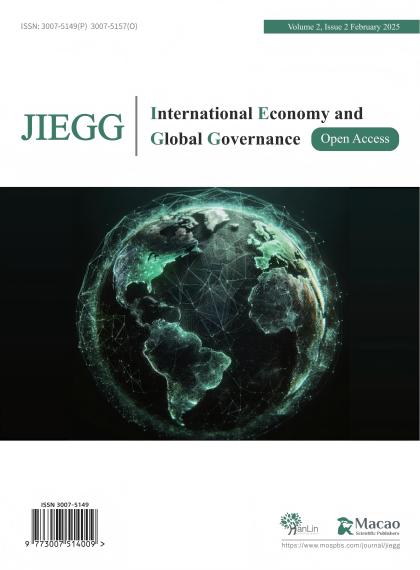-
Abdulaal, M., & Deen, A. (2024). The Discursive Strategies Used in Representing Refugees in the British News Media: A Critical Discourse Approach. World Journal of English Language. https://doi.org/10.5430/wjel.v15n3p103.
-
Selected Works of Marx and Engels (201). Volumee 3. People's Publishing House.
-
Li Chen. (2025). Technological Innovation, Artificial Intelligence and Great Power Military Competition,” International Security Studies, (1), 56-58.
-
Stavrianakis, A., & Stern, M. (2017). Militarism and security: Dialogue, possibilities and limits. Security Dialogue, 49(1-2), 3-18.
-
Adams, Paul; Lukiv, Jaroslav (2025). Ukraine claims drone strikes targeted one-third of Russia's strategic bombers. How should we view this “great victory”? BBC NEWS. https://www.bbc.com/zhongwen/articles/c1kvg24ddmxo/simp.
-
Euysun Hwang (2025). Lethal Autonomous Weapons: The Next Frontier in International Security and Arms Control. The Stanford International Policy Review. https://fsi.stanford.edu/sipr/content/lethal-autonomous-weapons-next-frontier-international-security-and-arms-control
-
Defense Primer: U.S. Policy on Lethal Autonomous Weapon Systems. (2025, February 01). https://www.congress.gov/crs-product/IF11150
-
Cai Zixing & Xie Bin. (2022). Robotics. Tsinghua University Press.
-
China Academy of Information and Communications Technology. (2024). “Humanoid Robot Industry Development Research Report (2024)”, p. 24. http://www.360doc.com/content/25/0104/11/49290572_1143728408.shtml.
-
Maja J. Matarić. (2007). The Robotics Primer. MIT Press.
-
Sam Korus, “How ARK Is Thinking About Humanoid Robotics,” https://www.ark-invest.com/articles/analyst-research/how-ark-is-thinking-about-humanoid-robotics.
-
For more details, https://www.thepaper.cn/newsDetail_forward_27384136; https://www.nsf.gov/funding/opportunities/nri-30-national-robotics-initiative-30-innovations-integration/503641/nsf19-536/solicitation; https://hichristensen.com/pdf/roadmap-2024.pdf.
-
Specific documents include: “New Generation Artificial Intelligence Development Plan,” https://www.gov.cn/zhengce/content/2017-07/20/content_5211996.htm;”Proposal of the Central Committee of the Communist Party of China on Formulating the 14th Five-Year Plan for National Economic and Social Development and the Long-Term Goals for 2035,” https://www.gov.cn/zhengce/2020-11/03/content_5556991.htm; and “Guiding Opinions on the Innovation and Development of Humanoid Robots,” https://www.ncsti.gov.cn/zcfg/zcwj/202311/P020231103482413965397.pdf.
-
Robert D. Kaplan. (2013). The Coming Geowar. Translated by Han Pu. Guangdong People's Publishing House.
-
CCTV. (2025). The world's first humanoid robot fighting competition kicked off in Hangzhou, and the event was a blast. https://www.eet-china.com/news/202505261805.html.
-
Daniel M. Gerstein & Erin N. Leidy. (2024) Emerging Technology and Risk Analysis: Unmanned Aerial Systems Intelligent Swarm Technology. Homeland Security Operational Analysis Center operated by the RAND Corporation. https://www.rand.org/pubs/research_reports/RRA2380-1.html.
-
808, ab. (2024). Eight Commonly Used Polymer Materials for Humanoid Robots. For details, https://www.aibang.com/a/51976.
-
Jacob Biba. (2025). Tesla’s Robot, Optimus: Everything We Know. Available at https://builtin.com/robotics/tesla-robot
-
Susan Vrijkotte, Bart Roelands, Romain Meeusen & Nathalie Pattyn. (2016). Sustained Military Operations and Cognitive Performance. Aerosp Med Hum Perform, 87, (8), 718-727.
-
Wang Teng. (2023). How can 'smart' AI improve the accuracy of intelligent targeting in combat?. https://junshi.gmw.cn/2023-07/24/content_36719170.htm
-
Liliana Oleniak. (2025). Russia's losses in Ukraine as of March 11: +1,300 troops, 198 drones, 75 artillery systems. https://newsukraine.rbc.ua/news/russia-s-losses-in-ukraine-as-of-march-11-1741679542.html
-
Александр Афонин. (2024). Минобороны раскрыло число уничтоженной техники ВСУ с начала СВО”. https://www.gazeta.ru/army/news/2024/12/25/24713816.shtml
-
Wang Peng. (2025). Humanoid Robots: A Technological Frontier Where Opportunities and Challenges Intertwine. China Daily Chinese website: https://column.chinadaily.com.cn/a/202503/05/WS67c807e0a310510f19ee9e12.html
-
Denise Garcia. (2023). The AI Military Race: Common Good Governance in the Age of Artificial Intelligence. Oxford University Press.
-
Herz, J. H. (2003). The Security Dilemma in International Relations: Background and Present Problems. International Relations, 17(4), 411-416.
-
Karen Münster & Ivan Arrequin-Toft. (2018). The Essentials of International Relations (7th Edition). Translated by Pan Zhongqi. Shanghai People's Publishing House.
-
Michael White. (2009). The Fruits of War: How Military Conflict Accelerates Technological Innovation. Translated by Lu Xinyu. Sanlian Bookstore.
-
Gary Zhou. (2025). Tesla’s Bold Leap into the Future with Humanoid Robots: The Optimus Endeavor. https://ilovetesla.com/teslas-bold-leap-into-the-future-with-humanoid-robots-the-optimus-endeavor/
-
Collins, A. (2004). State-Induced Security Dilemma: Maintaining the Tragedy. Cooperation and Conflict, 39(1), 27-44.
-
Military Compensation. (2007). https://militarypay.defense.gov/Benefits/Death-Gratuity/
-
Regulations on Military Personnel Pensions and Benefits. (2019). https://www.gov.cn/gongbao/content/2019/content_5468881.htm
-
Michael White. (2009). The Fruits of War: How Military Conflict Accelerates Technological Innovation. Translated by Lu Xinyu, Beijing: Sanlian Bookstore.
-
Li Ziyu. (2025). “A $2 million missile shot down an adversary's $10,000 drone.” The commander of the US Special Operations Command complained about the US military's heavy losses. https://world.huanqiu.com/article/4MD3pXZPjO8
-
Qin Yaqing. (2001). The Anarchism of the International System - Reading Winters' Social Theory of International Politics. The Chinese Journal of American Studies. (2), 137.
-
Sun Weiping. (2020). “Artificial Intelligence and Human's 'New Alienation'“. Chinese Social Sciences. (12), 122.
-
Don Eade. (2012). Technology and the Lifeworld: From Eden to Earth. Translated by Han Lianqing. Peking University Press.
-
Victoria Bekiempis. (2016). What Philip Zimbardo and the Stanford Prison Experiment Tell Us About Abuse of Power. https://www.newsweek.com/stanford-prison-experiment-age-justice-reform-359247
-
Chesterman, Simon. (2023). The Tragedy of AI Governance. NUS Law Working Paper,2023, No. 27.
-
From an ethical perspective, technology is a manifestation of human power and a form of action, and all human actions are subject to moral scrutiny.
-
Luciano. Floridi. (2024). Introduction to the Special Issues: The Ethics of Artificial Intelligence: Exacerbated Problems, Renewed Problems, Unprecedented Problems. American Philosophical Quarterly, 61(4), 301-307.
-
Wang Xiantao. (2020). Artificial Intelligence and the Loss of Humanity. https://bpr.studentorg.berkeley.edu/2020/11/15/artificial-intelligence-and-the-loss-of-humanity/
-
US plans to deploy an army of 100.000 humanoid robots: The AI revolution is already here. (2025). https://iartificial.blog/en/automation/US-plans-to-deploy-100-humanoid-robots-to-the-military/
-
Drones Should the U.S. Military Continue Drone Strikes? (2025).https://www.britannica.com/procon/drones-debate/Pro-Quotes
-
The Role of AI in Asymmetric Warfare: Transforming Strategies.https://totalmilitaryinsight.com/ai-in-asymmetric-warfare/
-
Pledger, Thomas. (2021). The role of drones in future terrorist attacks. Association of the United States army.
-
Qi Kai. (2024). Social Impact and Risk Governance of the New Generation of Artificial Intelligence. National Governance, (24), 37.
-
National Security Commission on Artificial Intelligence. Final Report. (2021), 9-11. https://assets.foleon.com/eu-central-1/de-uploads-7e3kk3/48187/nscai_full_report_digital.04d6b124173c.pdf
-
Ling Shengli & Yang Fan. (2019). The Evolution of China’s National Security Concept in the Past 70 Years: Cognition, Connotation and Response. International Security Studies, (6), 7.
-
Working Together to Build a Community with a Shared Future for Mankind: China's Initiatives and Actions, https://www.gov.cn/zhengce/202309/content_6906335.htm

